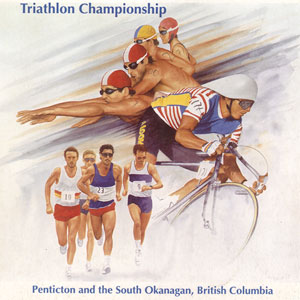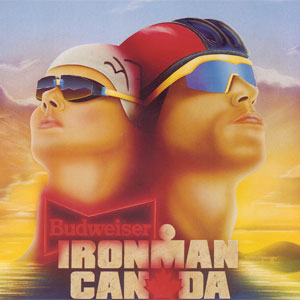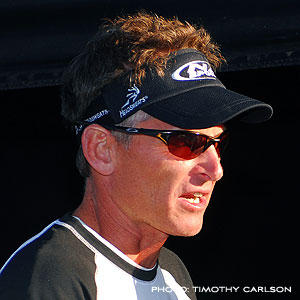Crisis in Canada

Penticton is looking for a buyer for its iconic triathlon. [Note that the Penticton Triathlon Race Society maintains it is not "selling" the event, rather looking for someone to "organize and execute" it]. This is the race that for 30 years was Ironman Canada, unless you discount the first 3 years, as it was fussing about with its name. It became Challenge Penticton a year ago, and the community-based race producers – the Penticton Triathlon Race Society – incurred $377,000 and change in debt, $200,000 of which is backstopped by the City of Penticton.
While the race was privately owned (or at least produced) until last year, there has been one or another Penticton-based non-profit involved with this race going back to its inception, which is rare in the racing world. When the race moved from Ironman to the Challenge brand, just after the 2012 Ironman Canada, the Penticton Triathlon Race Society was constructed to produce the race entirely – no private owner. This organization underwent a management review after conducting its first Challenge Penticton, and has decided this model of race governance is not ideal. While it will put on the race in 2014, the race will transfer to private ownership for the 2015 edition, though still under the terms of the Challenge license, which will have 3 more years to run once the new owner takes possession.
But this question of who owns the race, and who is selling it, is a bit of a moving target. The City maintains it does not own the race, but the City is the entity producing the “Expression of Interest and Statement of Qualifications (EOISOQ)” – roughly analogous to an RFP process – and will be the entity analyzing the results. Further, those organizations meeting the qualifications and moving to the next step will be presented to the City Council, the Council voting on what to do next. Maybe the Society owns the event. But the City is managing and fronting the process.
Why the confusion? Because the City according to its charter can't run a for-profit enterprise. But it was the City that entered into a license agreement with the Challenge brand, so the race is the responsibility of both the City and the Society.
The inaugural City-run Challenge race was a rough go. While 1,350 entered the event – half of traditional registrants – only 571 individuals finished. The City maintains that as of March 17th, 2014, north of 800 registrations have been taken. The local newspaper, The Penticton Western News, wrote that, “The inaugural 2013 race lost $377,000 and Mayor Garry Litke said prospective operators will need to take on the race’s debt.” The City’s EOISOQ does not say that, however. It just says that the City has incurred debt and, in consideration of that debt, “is seeking future profit sharing from the successful Respondent.”

Beginnings
This race was Ironman number-two, and was founded by Lynn Van Dove. Some have Ron Zalko founding the race, but it was clear that this race was Ms. Van Dove’s until she sold it in 1991. That first race in Penticton had 26 registrants. It was not yet an Ironman. A license from Valerie Silk – WTC was not incepted until Ms. Silk sold the race in 1989 – was not granted to the Canadian race until 1986.
When you talk to those who’ve owned, or run, or been involved with the running, of this Ironman race there is a consistent theme: That Ironman was not the brand, according to the city fathers; Penticton was the brand. There has always been a power struggle between the Penticton’s business interests and local politics on the one hand, and those who owned the race on the other hand. How did Ms. Van Dove feel about Penticton’s “upper crust,” as she characterized them? Here’s what she wrote, referring to the race society (a non-profit“ executive board),” in comments which can be found on her Shy Giants website:
“Valerie [Silk, Ironman’s original founder and race organizer] was never convinced that a society served much purpose. After a few more years of small-town politics and obvious dirty tricks, Valerie pulled the society’s license and re-assigned it to me privately. When the license was reassigned, I inherited their $100,000 deficit.
Valerie poignantly explained, “I won’t have malcontents attempting to catapult themselves into political or social prominence on the back of the Ironman at your expense.” From that day on, every piece of negative correspondence, every whiny phone call and every plea for changes Valerie received from the people Brian Porter described as “the weasels” were immediately forwarded to me.“
Note that these are not quotes from Valerie Silk to Slowtwitch, rather this is Lynn Van Dove quoting Valerie Silk from memory.

When you talk to the folks at the City of Penticton today, you don’t get the sense they regret entering into a license agreement with Challenge. They think they’re Challenge material. There are at least two races that reached their zeniths after severing ties with Ironman: the Wildflower Triathlon, and what was Ironman Germany in Roth, now Challenge Roth. Could Penticton be another? Can it still be another? The folks in Penticton that chose Challenge are taking the long view and, if the numbers have diminished from 2012 to 2013, it should be noted that this race never hit the 1000-entrant mark under Ms. Van Dove.
Salvation
The race was in trouble by the end of the 80s and was rescued by the Bregman brothers, Michael and Howard in 1991. Michael Bregman was busy at the time building Starbucks competitor “The Second Cup” from the chain he bought for $12 million to the eventual $175 million sale he later made. He is a principal in Tailwind Capital (not to be confused with Tailwind Sports). The Bregmans bought the race, and produced it through 1995.
The Bregmans were already sponsors of Graham Fraser’s Eastern Canadian triathlon series, and sold the race to Fraser in 1995 for their original investment, according to Fraser, plus the assumption of about $100,000 in race debt. It was a risk. At that time about 1,200 athletes were racing. You could arrive at the event and sign up then and there.
The race steadily grew. In the next year the race had 1,500 contestants, a record, and by the turn of the century the race hosted about 1,700 athletes.
Prosperity
By the middle of the decade the race had reached its maximum field of between 2,800 and 3,000 athletes.
By 2009 WTC had made its transformation from a company based on licensing to an event production company, and assumed ownership and production of all of Mr. Fraser’s Ironman races in the United States (Couer d’Alene, Lake Placid, Florida and the like). Mr. Fraser still owned the Penticton race, and by 2011 he had pared the field limit by 700 athletes, at WTC’s request. By then it was clear that the proliferation of Ironman races on the calendar made each race more regional, and the region around Penticton was not that populated. By 2011 the race, even with 700 fewer people, took 10 days to fill instead of 4 hours, which was the case just a couple of years before. The Penticton race was no longer going to be an easy, automatic fill, and that was before Ironman Whistler.

The race in 2012 was last one Graham Fraser owned and produced. The Penticton people already had the Challenge folks in discussions, and Slowtwitch chronicled the last minute, furious efforts of WTC to keep this race.
If one looks at the situation now, it seems as if the question of whether the strongest brand was Ironman or Penticton has been settled: It’s Ironman. But Google ads for both Ironman Whistler and Couer d’Alene are still running as of this writing, which means none of these three races – the two Ironman races and Challenge Penticton – have filled. It’s a race for bodies in the Northwest.
The Opportunity
It’s going to be a Challenge race, at least for the three years the new owner will produce the race. Several interviewed for this story echoed the same sentiment: the mentality among the locals in power in Penticton is that this race should not be a means by which profit is funneled out of the community; and that Penticton sees itself as the brand, and is therefore unwilling to produce the kind of deal enjoyed in other communities. But that was a year ago. The City has now had a taste of race ownership and the risks associated. By owning its own race it is liable for the financial downside, and vulnerable to the indignities of the publication in the local media – because of freedom of information laws in Canada – of eye popping losses.
Those who run things in Penticton are honestly befuddled when asked, “Who owns this race?” Both Simone Blais, Penticton’s communications director and Judy Sentes, long time city council member, and the president of the race society for much of the last 30 years, had a hard time answering that question. This race is seen by Pentictonites – my own words, my own characterization – like a communal farm. Everybody does his share hoeing, planting, watering, weeding, harvesting, but it belongs to no one. The problem comes when the responsibility for paying the bills falls on one party. The City felt that responsibility for the first time this year, hence the offloading of this property. If it is a property.
“I have heard from two people involved in former ownership of this race the same sentiment,” I asked Ms. Sentes, “that the community takes umbrage with the idea of a race run for a profit motive, and that profit is taken out of Penticton.”

“I’m not going to deny that,” she replied. “My attitude is, as long as our community is making money, it doesn’t matter that someone on the other side is making a tidy profit. But others have an anxiety about that. Penticton takes ownership. They do. But they have to understand ownership. We own the hospitality, we own the hotels,” she said, but she rued the fact that some community members did not understand that he who risks should be allowed to reap the rewards of his risk. “It’s hard for people to get their heads around all of that.”
The rift with Ironman was not with the Ironman brand. “It got to a stalemate between Penticton and the Ironman; Challenge was more amenable,” said Ms. Sentes, to the personality of the race and the community. “Having a family, or Graham Fraser, hold the franchise is far different from a corporation [Providence Equity Partners] holding the franchise.”
Ms. Sentes mentioned that the community nature of the race should mean that money is earned and spent through the non-profit and funneled back via philanthropy. “Did not Graham Fraser donate north of $1 million into the community during his time owning the race?” I asked.
“Graham did give back,” she said. “He did. It’s sad that people might forget that. We weren’t so sure once the license was back in the hands of WTC, that might not happen.”
The City of Penticton seems to have more of a problem with the style of ownership of WTC than with WTC. But the “Expression of Interest” has no conditions or exclusions. Private Equity firms are not excluded from expressing interest.
Penticton is not the first city that has been conflicted about the reason an event like this exists; who owns the race and should own it; whether there’s a limit to how much money an event promoter should be able to earn in an event in that town. A look at the ownership and race production history at the Catalina Triathlon would be instructive. The successful bidder for the right to produce the race in Penticton might not be truly successful unless he or she has not just deal points agreed upon with the City of Penticton, but a clear understanding of who has the authority, and the responsibility, and the ownership, and both the legal and ethical rights, to produce and profit from an international event domiciled in that City.
Images, top to bottom:
Detail from race poster, 1987
First race in 1983
Finisher in 1985
Ray Browning wins a late ‘80s edition
Triathlon Jesus: Poster for the 1990 Race
All images are from and by permission of Lynn Van Dove – thanks, Lynn



